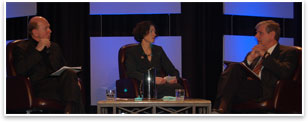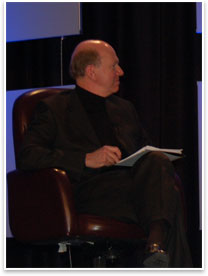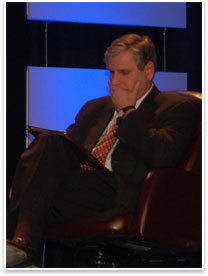|
Chief Editor and Chief Economist Agree: Now Is the Time to Prepare for a More Prosperous Future
by Stephanie Stubbs, Assoc. AIA, LEED-AP
Managing Editor
 Summary: For this year’s Town Hall Meeting at the Grassroots Legislative and Leadership Conference on February 6, AIA Executive Vice President/CEO Christine McEntee invited Architectural Record Editor in Chief Robert A. Ivy, FAIA, and AIA Chief Economist Kermit Baker, PhD, Hon. AIA, to answer questions about the economy and how the profession of architecture should go forward. McEntee assembled questions from the participants and served as moderator for Ivy and Baker, both of whom agreed that architects should use this economic “down time” to design a better future for the profession and the clients it serves. A video will be available soon of the Town Hall meeting; watch AIArchitect for details. In the meantime, we bring you the top line of the discussion, below. Summary: For this year’s Town Hall Meeting at the Grassroots Legislative and Leadership Conference on February 6, AIA Executive Vice President/CEO Christine McEntee invited Architectural Record Editor in Chief Robert A. Ivy, FAIA, and AIA Chief Economist Kermit Baker, PhD, Hon. AIA, to answer questions about the economy and how the profession of architecture should go forward. McEntee assembled questions from the participants and served as moderator for Ivy and Baker, both of whom agreed that architects should use this economic “down time” to design a better future for the profession and the clients it serves. A video will be available soon of the Town Hall meeting; watch AIArchitect for details. In the meantime, we bring you the top line of the discussion, below.
Difficult economy: Time to put a new infrastructure in place
“I have no silver bullet for this economy,” Ivy declared at the start. Although representing McGraw-Hill Construction and Architectural Record at this town hall meeting, Ivy also drew upon his experiences as a practicing architect to talk about the current recession. “I can tell you we have been here before—maybe not as deep, but we have been here. We hope that we’re at the bottom of the sine curve now,” he said. “We can’t bank on what we have planned on before. We have to develop new strategies.”
Ivy posited that we might see some new building types as we emerge from the downturn. “The good news is that our clients need us more than ever to be smart for them and be their partner,” he said. “We can use this downturn time to plot strategies for the future. This is time to be used, to think strategically, as we don’t have time to do when we are busy.”
Ivy outlined three concepts for architects to think about.
 1. The architect’s role, both traditional and changing, in health, safety, and welfare. Architects need to consider what pressures are affecting public health today, from climate disaster to obesity, and concentrate on how to design the built environment to alleviate those risks designers can affect. We know we can make it easier for people to exercise, that we can make an effect on mental illness, that how we create space affects behavior. Articulation of these kinds of design issues will make us more relevant to the public, Ivy said. 1. The architect’s role, both traditional and changing, in health, safety, and welfare. Architects need to consider what pressures are affecting public health today, from climate disaster to obesity, and concentrate on how to design the built environment to alleviate those risks designers can affect. We know we can make it easier for people to exercise, that we can make an effect on mental illness, that how we create space affects behavior. Articulation of these kinds of design issues will make us more relevant to the public, Ivy said.
On a larger scale, cities are growing into mega-regions, Ivy noted. As we see this growth and demographic change, what about materials demand? How will we meet the needs? And with an increasing demand for green energy, we as architects can help institute some commonsensical changes into the built environment, changes that can positively influence health and well-being.
2. Socialization of information. We have to consider what social media tools will be integrated with design processes and what effect Web 2.0 and tools that currently are available on the AIA’s Web site can have. What role will gaming play? Then we need to consider what Web 3.0 will be like: components of intelligence that will come through the software itself—not people.
3. Human capital and changing demographics. Ivy urged the audience to consider changing demographics and the resulting effects on architecture and its practice. For instance, the U.S. population is expected to top 420 million people in 2050. Almost a quarter of the U.S. population at that time will be Hispanic; and, by 2030, 20 percent of the population will be over 65 years old. These demographic changes will all affect both the built and the natural environment, Ivy reminded the audience. “Sustainability questions devolve from demographics,” he said. And think also about the ever-increasing diversity of the workplace, where more women and minorities are taking their places. “Think also about how transportation will change radically—for instance, the rise in telecommuting—how will that affect architecture? Perhaps it will mean more forms of licensure, perhaps increased specialization, perhaps more part-time architects,” he said. “We may see a need to outsource our services.”
“These are strategic directions that we are fairly confident about,” Ivy concluded. He advised architects to consider these arenas of thought and position themselves and their firms to meet new challenges while they have the time to think about them.
Need for a new economic blueprint
Baker said his message was the same as Ivy’s: As a profession, we need to figure out how we get from where we are to where we want to go in the future. The numbers are not pretty. Although the recession “officially” started in December 2007, homebuilding has been spiraling down since early in 2006, Baker said. And because of globalization, problems in the U.S. economy have quickly become international economic problems.
The U.S. Gross Domestic Product dropped at a 3.8 percent annual rate in the fourth quarter of 2008, signaling the worst drop in 25 years. And figures released by the Bureau of Labor Statistics on February 6 indicate that the unemployment rate stands at 7.6 percent, the worst in 16 years. Baker reported that 25 percent of payroll losses overall are in the construction industry; the architecture profession per se has seen a 7.5 percent decline. “We are now a full year into the downturn of our profession,” Baker said. “The last three of our Architectural Billings Index reports have been the three lowest ever.”
 The latest AIA Consensus Forecast predicts an 11 percent decline in construction activity this year and 5 percent next year, Baker said. Although this recession seems to be following the same track as the 1994 recession, the difference is that the housing sector decline this time is much more serious. Nonresidential construction declines generally last three years; the last spanned 2001–2003. We’re in our second year, according to the chief economist, and we still have a ways to go. The latest Architecture Billings Index poll indicates that one third of firms think they will have to cut more staff this year. The latest AIA Consensus Forecast predicts an 11 percent decline in construction activity this year and 5 percent next year, Baker said. Although this recession seems to be following the same track as the 1994 recession, the difference is that the housing sector decline this time is much more serious. Nonresidential construction declines generally last three years; the last spanned 2001–2003. We’re in our second year, according to the chief economist, and we still have a ways to go. The latest Architecture Billings Index poll indicates that one third of firms think they will have to cut more staff this year.
The federal government is our best hope for the present, Baker said. Some $40-50 billion would add an extra 5 percent annually for infrastructure. But we need to be creating a blueprint for building a new economy. And it has to be built on the current realities that incorporate sustainable design, education, and modern, efficient infrastructure. We also need to make a greater effort to upgrade our existing housing stocks. “Architects will obviously play a leadership role,” Baker concluded. “We will be playing a role even more central to designing our new economy. Let’s just hope this happens sooner rather than later.”
Questions about the economy
Q1.: Interns and young professionals are traditionally the first to lose their jobs. How do we avoid losing a whole generation of architects again (as we did in 1991-1992)?
Ivy: We know we can do this, if we prepare. It’s a question of helping and mentoring. We need to support them, show them how to get and keep work. If we can, we may have to change the way our offices are organized, maybe go to a four-day work week rather than let people go. We can sponsor networking meetings, like AIA New York’s “Not Business as Usual” meetings. We can become more flexible and move. And just think—we didn’t have Craig’slist back then.
Q2. How can firms navigate through this economy?
Baker: Firms need to be prepared for the long haul. We need to help build a greener economy, one that is very much focused on efficiencies. We need to be the best player internationally, using strategies such as Integrated Project Delivery—with BIM to implement it. We also need to start laying the groundwork to branch out into other areas, notably the sustainability realm.
Q3. [At this time] we are waiting to hear about the stimulus package. In the meantime, we hear that there are projects ready to go, but funding is unavailable. What needs to be done to free up credit market?
Baker: We didn’t appreciate that our credit markets were this vulnerable. There’s talk of using TARP [Troubled Assets Relief Program] money to help. This process has gone on for a while, and it may take the government stepping in and offering some kind of insurance. We need to solve the credit market problem to solve the economic problem.
Q4. We are surrounded by gloom and doom. How do the media impact the market?
Ivy: The media need to be savvy—media no longer means just the New York Times, Time magazine, and Newsweek. That’s a good thing, because it allows us to identify people who want to talk together and lets us reach out to other communities—a variety of folks we want to work with. Through both electronic media and traditional media, we have a good story to tell. At the time we are being challenged, we have some answers. We know how to make buildings that are more responsive to the environment and how to retrofit buildings. We know that we can help make positive changes.
 Q5. Contractors are taking over our role in the building industry. What can we do? Q5. Contractors are taking over our role in the building industry. What can we do?
Ivy: I always believe the best defense is a good offense. I think we succeed by showing that we are truly leaders and consistently making our message clear. This is not a new message.
Baker: Interdisciplinary teams show that we’re making progress. Showing that we are leaders in those teams will strengthen our roles.
Q6. How can architects create a role in addition to their traditional role now to get prepared for the new economy?
Baker: Keep close to clients and what their needs are. We need to talk their language and offer creative solutions to their problems.
Q7: How long will this recession last?
Baker: The consensus is that we’ll be out of recession by the fourth quarter of this year. There’s never been a recession since the Great Depression that lasted more than 16 months. But the timing also will depend on the Stimulus Plan. We’ve got a lot riding on this package—and it’s a lot more art than science.
Q8: How quickly will we feel the effects of the stimulus plan?
Baker: The stimulus package is like a time-release capsule—some medicine kicks in right away, some later, some later than that. About a third of the money goes to tax cuts and rebates, and that should take effect quickly. About two-thirds are spending parts that create jobs and projects, but they don’t happen that quickly. We won’t feel that effect until 2010. If it works, the quick burst should affect the stock market soon. Then we’ll see it in the job reports as employment starts to move into growth.
Q9: What should we do about our long-term savings? My 401K looks like a 201K!
Baker: Personally, my strategy is to work until I’m 80! Really, though, talk to your investment advisor. Those nearing retirement may not have much of a taste for risk; younger people might try for more risk. A lot of us are more risk-averse right now, but it’s a personal decision—no one size fits all.
Q10: How do you convince people to build and use public transportation and provide amenities for it?
Ivy: Obviously, this is something we want, and we need to demonstrate the positive result with data from case studies. We also need to demonstrate the sustainability results of people moving away from cars. I also want us to focus on the building aspect. If we can make positive design of cars and buildings intersect, we will have achieved something. We need the research data, and then we need some strong marketing for the concepts.
Q11. As Editor of Architectural Record, do you see success stories?
Ivy: Yes, we’re seeing lots. Seattle and Portland, for instance. Denver also comes to mind with its new, mixed-use districts and higher densities. We’ve also seen great work in Europe—density could mean vertical gardens. Urban agrarians are growing things on the sides of buildings. As it’s getting denser, it’s actually getting healthier.
 Q12. If the stimulus bill passes, could we have an alternative energy market? Q12. If the stimulus bill passes, could we have an alternative energy market?
Baker: I think it has potential if implemented properly. We have to let the market drive it. Those who can afford to should implement it.
Q13. What’s your advice for the AIA leadership?
Baker: I think it’s got to be one battle at a time. And once we get the economy moving again, their priority should be a drive to do things right in the new economy.
Q14. How should American architects think about the potential import of architectural services from overseas?
Ivy: Many of them are already here, and that creates opportunities for all kinds of collaboration—of smaller firms and larger firms. I just came back from Dubai, and I know that there is no silver bullet for American firms looking for work abroad. But I urge you to look carefully at it—this is a period for examining and seeing what the opportunities are.
Baker: It may happen in ways that we don’t expect. In this Internet-connected world, it can happen in a lot of ways.
From the live audience:
Q 15: How is architectural education changing to address this new future?
Ivy: This economy is creating a new set of opportunities—new building types, tools, and skill sets. The architect of the future needs not only technical skills but communications skills. We need to learn how to share ideas clearly with the rest of the world—and we need to learn that in schools.
The schools also need to acknowledge the multiplicity of places where architects can be involved and expose students to the range of opportunities in government, etc. There is a range—and we need to do that range of things. And in the profession, there needs to be room at the table for all those skills.
Baker: I’d like to add more exposure to business skills to the communications skills.
Q16. Do you think we need to change architectural licensure?
Ivy: I think we need more options instead of more protectionism. We need to develop systems that take advantage of different skill sets. Can we devise new forms of licensure?
Q17: What about options for regional economies where economic problems are deeper? In Michigan, we’ve been struggling for many years. What if you want to stay in the profession but don’t want to move?
Baker: Michigan is the Ground Zero of the current economy, because it has a single-base economy, the automobile industry, which has been struggling for many years. The state needs diversified growth strategies, and, truthfully, it doesn’t look very encouraging right now. I would say the best thing to do would be to take advantage of Internet economies. It doesn’t matter anymore where you are to do what you do, you can still practice virtually and on a global scale. I would leverage it from that standpoint.
Ivy: Drawing from my experience in practicing in the poorest state in the country, Mississippi, my advice is: Don’t retreat from quality in whatever you do. The unique and distinguishing characteristic of what we as architects can offer to society is quality. Don’t settle. |


 Summary:
Summary:


 Q12. If the stimulus bill passes, could we have an alternative energy market?
Q12. If the stimulus bill passes, could we have an alternative energy market?